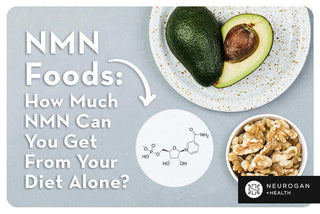Higher nicotinamide adenine dinucleotide (NAD+) levels in the body are associated with a healthy aging process. One of the best ways to ensure we maintain this as we age is to get a regular intake of NAD+ precursors like nicotinamide mononucleotide (NMN), which can come naturally from foods like broccoli, cabbage, and avocados.
However, the best way is to take NMN supplements, giving you a concentrated and steady dose of NMN.
If you want to get more NMN with a balanced diet, we'll highlight some of the top NMN-rich foods and how they might compare to taking NMN supplements.
Natural Sources of NMN

You can get NMN naturally through foods like shrimp, avocado, and broccoli, but they come in very small amounts compared to what you'd be getting from an NMN supplement.
Here's a comparison of each food source of NMN and how much you'd have to eat to get the equivalent of one serving of Neurogan Health NMN capsules (900 mg).
|
Foods |
NMN Per 100 g |
Other Benefits |
How many do you need to eat to compare to 1 serving of Neurogan Health NMN Capsules |
|
Avocado |
0.5–1 mg |
Contains healthy fats, vitamins, and minerals |
90,000 - 180,000 g (450 - 900 whole avocados) |
|
Nuts |
0.5 mg |
Various nuts provide NMN along with healthy fats, protein, and fiber. |
180,000 g (6,000 handfuls of nuts ) |
|
Cucumbers |
0.1 mg |
Contains a lot of water and a modest amount of natural NMN. |
900,000 g (3,000 cucumbers) |
|
Tomatoes |
0.3 to 0.9 mg |
Fresh tomatoes contain NMN and are a great source of vitamins A and C. |
100,000 – 300,000 g |
|
Milk |
0.1 mg |
Dairy products like milk contain NMN and are also rich in calcium and vitamin D. |
900,000 mg (3,750 glasses of milk) |
|
Beef |
0.06 to 0.1 mg |
Beef is a good source of protein and essential nutrients. |
900,000 – 1,500,000 g (3,965 - 6,608 plates of 8oz steaks) |
|
Shrimp |
0.3 mg |
Shrimp also has omega-3 fatty acids and other nutrients. |
300,000 g (20,000 shrimp) |
|
Fish |
0.05 to 0.1 mg |
Certain fish, especially fatty fish, contain NMN and are rich in omega-3 fatty acids. |
900,000 - 1,800,000 g |
Even with the best source of NMN, avocados, you'd need to eat 450 - 900 whole avocados to get the equivalent of one serving of Neurogan Health's NMN supplement [1, 2]
As you can see, while you can get NMN from a balanced diet, it's not near the quantities found in scientific studies investigating the benefits of NMN for supporting NAD+ levels, which range between 250 - 900 mg daily depending on the individual's lifestyle and wellness goals [3].
Best Source of NMN

The best source of NMN is vitamin B3, also known as niacin. Your body converts vitamin B3 into niacinamide and then NAD+, which is used by cells for energy metabolism, DNA repair, and hundreds of other cellular processes.
Foods high in Vitamin B3 include:
- Tuna: Contains about 22 mg of Vitamin B3 per serving.
- Turkey: Provides around 10 mg of Vitamin B3 per serving.
- Peanuts: Offer about 4 mg of Vitamin B3 per serving.
According to the National Institutes of Health (NIH), the recommended dietary allowance (RDA) for vitamin B3 for Adults (19 years and older) is 16 mg for men and 14 mg for women [4].
When it comes to vitamin B3, there is such a thing as too much of a good thing. The maximum recommended daily dosage for adults is 30 mg. Taking more than recommended can lead to toxicity that can lead to flushing (redness and tingling on the skin), gastrointestinal upset, liver damage, glucose intolerance, and vision problems.

Where Does NMN Come From?

NMN is found in all living organisms and is crucial in cellular energy production.
While the foods listed above are good sources, the amount of NMN they provide can vary, and they don't come in significant concentrations in the recommended serving sizes to contribute to supporting NAD+ levels, which is why taking NMN supplements will provide much more support for your overall cellular health.
How NMN is Made for Supplements
NMN supplements are typically produced through a series of biochemical processes in a lab setting.
The most common method involves the biosynthesis of NMN using nicotinamide (vitamin B3) and ribose-5-phosphate.
This involves a series of enzymatic reactions, where specific enzymes facilitate the conversion of these precursors into NMN, which would normally happen in the body. So, let's get into the finer details of how this looks.
- Fermentation: Certain microorganisms, such as yeast or bacteria, are genetically modified to produce NMN. These microorganisms are cultured in a controlled environment where they convert nicotinamide and ribose-5-phosphate into NMN through their natural metabolic processes.
- Chemical Synthesis: NMN can also be synthesized through chemical reactions in a laboratory setting. This method involves the chemical coupling of nicotinamide and ribose-5-phosphate, followed by purification processes to ensure the final product is pure and free from contaminants.
- Enzymatic Synthesis: Enzymes initiate the conversion of nicotinamide and ribose-5-phosphate into NMN. This method is highly efficient and produces NMN with high purity and yield.
Once synthesized, NMN is purified and tested for quality and potency before being encapsulated or formulated into various supplement forms, such as capsules, powders, tablets, tinctures, or gummies.
Rich Foods that Have NMN
NMN can be found in certain foods, with avocados having one of the highest natural concentrations of this compound. You'd still need to eat 400-900 avocados daily to reach 900 mg of NMN — which is an absurd amount of avocados.
It's still a good idea to add NMN-rich foods to your diet as they contain other nutrients like healthy fats, protein, minerals, and other vitamins, but if you're looking to increase your NMN intake drastically to support a healthy aging process, you'll need a lot more than what you can get from your everyday foods.
Resources:
- NADase, C. Recent research into nicotinamide mononucleotide and ageing.
- Alegre, G. F. S., & Pastore, G. M. (2023). Nad+ precursors nicotinamide mononucleotide (nmn) and nicotinamide riboside (nr): Potential dietary contribution to health. Current nutrition reports, 12(3), 445-464.
- Yi, L., Maier, A. B., Tao, R., Lin, Z., Vaidya, A., Pendse, S., ... & Kumbhar, V. (2023). The efficacy and safety of β-nicotinamide mononucleotide (NMN) supplementation in healthy middle-aged adults: a randomized, multicenter, double-blind, placebo-controlled, parallel-group, dose-dependent clinical trial. Geroscience, 45(1), 29-43.
- National Institute on Aging. (n.d.). Vitamins and minerals for older adults. U.S. Department of Health and Human Services. https://www.nia.nih.gov/health/vitamins-and-supplements/vitamins-and-minerals-older-adults




